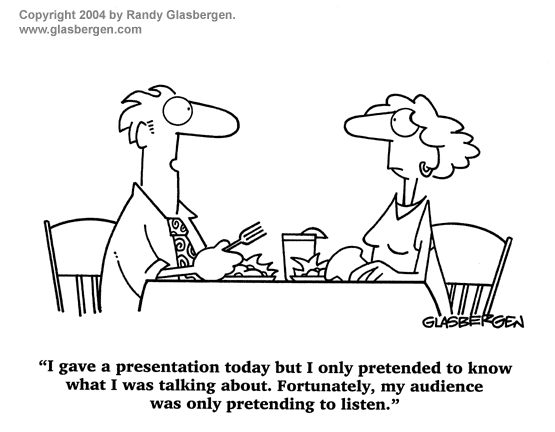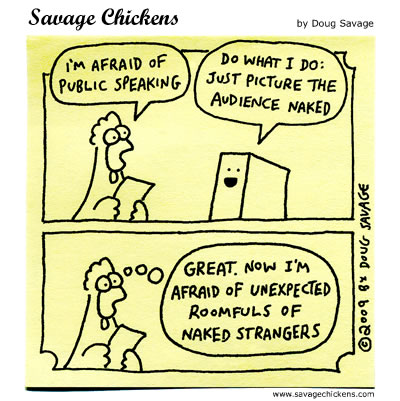 |
| Image retrieved from this site. |
But, after my gut reaction passed, I thought that public speaking might be the perfect course to tackle this interesting and innovative idea. I drafted a 25/25/50 rule: each student self-graded up to 25 points, the peer grades were averaged out of 25, and I provided the remaining 50. The article noted that few professors give scores below 50%. If 50% is given automatically, why not give the students some autonomy and control over that experience? I gave it a shot and this is what happened.
Overall, I found that the students were quite fair to themselves and their classmates. With the knowledge that everyone was peer-grading, there was a collective dependence on giving everyone decent scores. I averaged grades and all scores were anonymous, but the students still felt responsible for creating a supportive and welcoming environment. Even when comments were quite harsh, "This didn't really address the prompt, not sure I understood it," students (except for 1) still never graded below a 20/25. Across all speeches, there was agreement between the student self grade and the peer grade. Students, on average, gave themselves a 23.6 and the class gave them a 23.4. Even given the opportunity, only 1 student gave themselves perfect 25/25 across all 4 speeches. This same student also received the highest peer grades and the highest score in the course, despite the student having the third highest score from myself, on average.
 |
| Image retrieved from this site. |
There were no statistically significant differences between grades and a student's race, but there were some interesting patterns. The top three peer graded students were Caucasian while the lowest three were students of color. Overall, though, the peer grades spanned 24.4 to 22.8, a difference of 6%, which could bump a student half a grade. The students of color were also more likely to give themselves lower peer grades. For example, the lowest average self grades, 22.25/25, 22.88/25, and 23.50/25 were all students of color (and two international students). One student (briefly mentioned above) gave consistent low scores to two students of color, averaging a 19.3/25 and 18.2/25. These discrepancies and outlying scores did not affect the overall student average nor did it vary significantly from peers. Because of the low number of students in the class, teachers may want to keep potential biases in mind (for themselves and students participating in peer grading).
| Image retrieved from this site. |
The self- and peer- grading was done through an app that I previously wrote a post about: Socrative. In the past, I used this app for pop quizzes and anonymous feedback, but in Public Speaking, I used it for immediate scoring of students after speeches. I did not allow technology use during speeches, but started the Socrative quiz for students to give feedback out of 25, with both positive comments and constructive criticism.
I also used Socrative to asked students how they liked the self- and peer- grading. In response to the questions, "I like the method of self and peer grading in COMM 204 this summer," all students responded "Agree" or "Strongly Agree." In response to "I felt like I had more control over my grade because of the self and peer grading policy," I only had 2 neutrals, with the rest "Agree" and "Strongly Agree." In response to "The self and peer grading makes the grading process more fair than just having a teacher grade," I had one neutral response and the rest "Agree" and "Strongly Agree." I had the same one neutral student in response to "I felt that my classmates and myself were reasonable and accurate graders." Students were more neutral towards, "I think that peer and self grading could work in other COMM classes," with four neutrals and the rest, "Agree" and "Strongly Agree." The students all marked "Agree" or "Strongly Agree" with "The self and peer grading policy has positively affected my experience in COMM 204."
 |
| Image retrieved from this site. |
In the comments, the students were quite candid about how they marked themselves and others. One student admitted, "I felt that I was obviously more bias about grading myself than my peers. I tried to be as unbias[ed] as possible, but I think it was easier for me to mark someone off for something than myself." One student noted the potential risk, "It's an interesting system to implement, although it also relies on the assumption that your classmates also grade you honestly and fairly." Other students saw the process as very beneficial: "Getting to know peer and teacher feedback helps improve and motivate me and helped me boost my confidence."
Overall, I think this experiment was a success. The students responded positively to the policy, despite concerns at first. I was sure to emphasize the community aspects of the course and how important it was to be both fair and supportive. I think this helped the students see the benefit of engaging with this grading system and giving their full attention to their peers. I could imagine this process working well in other classes that might do presentations. In COMM 206: Communication and Culture in Spring 2015, I had many students mentally check out during student presentations about readings. If the students were tasked with grading, however, and knew that they would be as well, perhaps they would pay more attention to their peers. I'm happy that I experimented with this teaching experiment and would encourage students in a Public Speaking or other presentation-heavy course to try it out as well.
